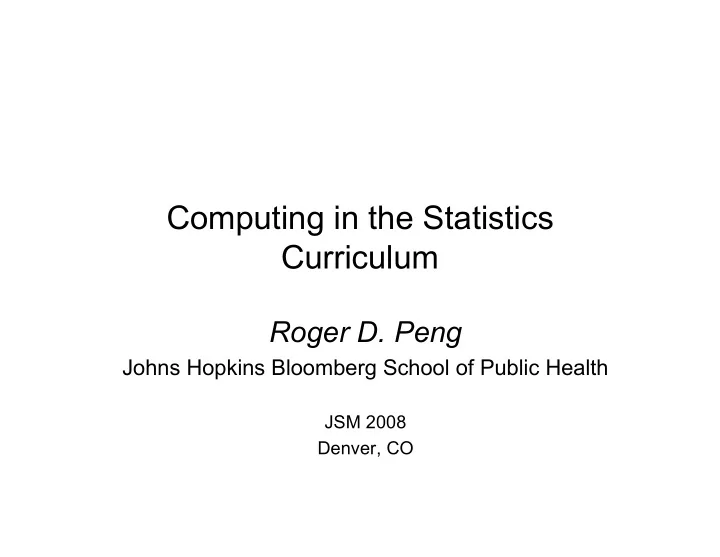

Computing in the Statistics Curriculum Roger D. Peng Johns Hopkins Bloomberg School of Public Health JSM 2008 Denver, CO
It goes against the grain of modern education to teach children to program. What fun is there in making plans, acquiring discipline in organizing thoughts, devoting attention to detail and learning to be self-critical? Alan J. Perlis
Computers have been around for a while…
Computers have been around for a while…
Changes in Computing: Then…
…And Now
Statistics Curriculum: Then… RA Fisher, Statistical Methods for Research Workers
...And now? Casella & Berger
Bickel & Doksum
Discussing the statistics curriculum It’s personal!
How is the world different today? • High throughput technologies for collecting vast quantities of data • Large databases for investigating subtle associations • Interactive computing with advanced statistical algorithms • Sophisticated searches across models and variables to identify important risks • Statisticians working at the interface with science
Statisticians are “part of the problem” (in a good way!)
Where do statisticians belong? Y = X β + ε Rectangular Microarray image data frame Mouse, Person, lung Carbon, NH 4 cell, gene Medicine Biology Chemistry
Statistician’s toolbelt grows • A facility with computational tools is becoming necessary to interact with people doing cutting edge science – databases – web services, XML • Not everything can be crammed into a rectangular data frame • “It’s a poor workman who blames his tools (or lack thereof)”
Statistician as scientist • Courses in computing can be used to train students to act like scientists rather than automatons • We can collect our own data • To interact with data, we need data technologies
“I must find out where my people are going so that I can lead them” • Complex data are being generated in all areas and new technologies are being applied to deal with them • Other fields are getting sophisticated – e.g. Majors/PhDs in bioinformatics or statistical genetics • Should we lead or let others show us the way?
B Fry. Visualizing Data
What are other fields doing?
Washington University in St. Louis School of Medicine • “This PhD program [in statistical genetics]...offers an interdisciplinary approach to preparing future scientists with analytical/statistical, computational, and human genetic methods for the study of human disease.”
USC Keck School of Medicine • “The objective of the PhD program [in statistical genetics] is to produce a statistical geneticist or genetic epidemiologist with in-depth statistical and analytic skills in biostatistics, computational methods and the molecular biosciences.”
What are we doing?
JHSPH Biostatistics • “The PhD program of the Johns Hopkins Department of Biostatistics provides training in the theory of probability and...biostatistical methodology. The program is unique in its emphasis on...requiring its graduates to complete rigorous training in real analysis- based probability and statistics, equivalent to what is provided in most departments of mathematical statistics. ”
UC Davis Statistics • “the core program for every graduate student in statistics includes graduate level core courses in mathematical statistics, applied statistics and multivariate analysis. Students obtain training in computational statistics and can choose from a variety of special topics courses.”
Where do statisticians belong? xkcd.com
Where do statisticians belong? Statisticians xkcd.com
Obstacles • Institutional: Curriculum development slow and narrow in focus (also Gibson’s Law) • Views – Computing can be self taught and picked up as you go – Computing is just a skill and should not be part of the curriculum • Faculty training: We are not taught this; it’s not natural for us like math
Obstacles (cont’d) • It’s easy to add material to the curriculum, but we can’t keep students in school forever – What material do we subtract? – Is computing part of the “core” or is it “extra”? • Resource allocation: faculty who are teaching computing to 20 students could be teaching Intro Stat to 200 students
Who can teach this? • Statisticians with a strong computing focus appear “randomly” in the field • Can we depend on this point process forever? – No: λ (t) is going to 0. • These people will continue to appear but there may not be a compelling reason for them to go into statistics (or be in a statistics department)
Can we depend on other departments? • I’m not sure.... • Engage CS departments to tailor courses for us? • Political reasons
JHU BA Program in Biology (core courses)
We can just conduct one big observational experiment and see who wins.
Some fields manage to absorb change, but withstand progress. Alan J. Perlis (adapted)
Recommend
More recommend